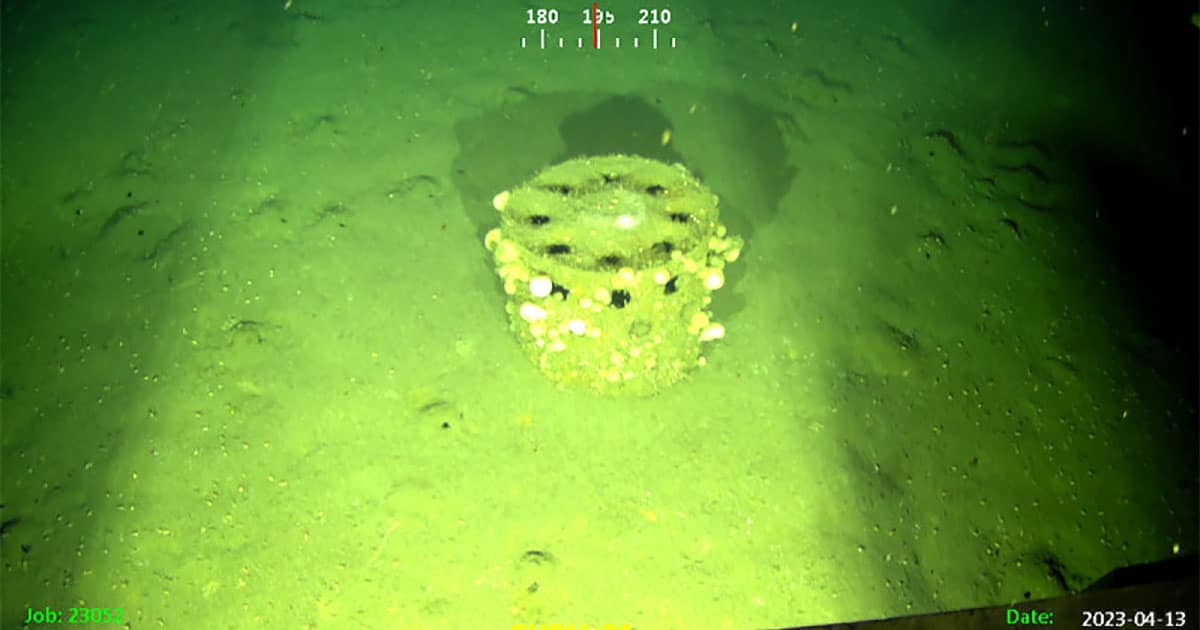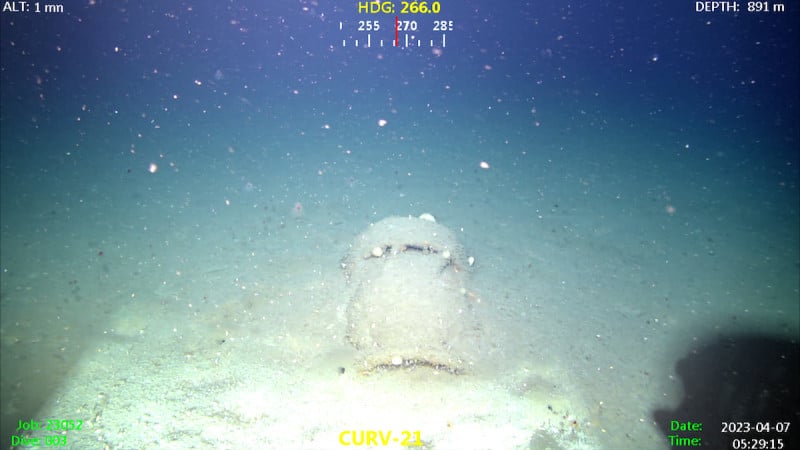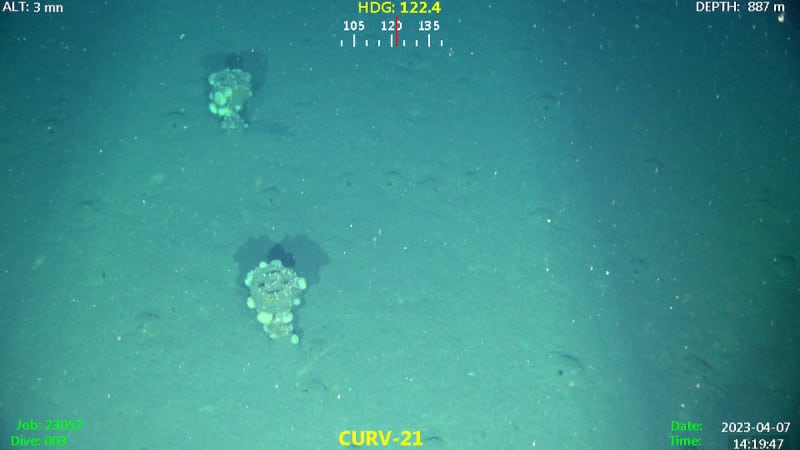Led by Scripps oceanographers Sophia Merrifield and Eric Terrill, the 2023 survey used a deep water autonomous underwater vehicle (AUV) with state-of-art synthetic aperture sonar and a remotely operated vehicle (ROV) with an HD video camera, both capable of working up to full ocean depth of 6,000 meters (19,600 feet). The expedition took place with support from the US Navy’s Supervisor of Salvage and the Office of Naval Research.
Between the 1930s and 1970s, the site was a known location for industrial dumping, including byproducts from the manufacturing of the pesticide DDT, and was initially surveyed using robotic vehicles by the same team in April 2021. The goal of the second survey was to extend maps of the seafloor using higher resolution acoustic sonar imaging techniques, to apply video imaging systems to classify objects in a previously mapped debris field, and to collect observations of deep-sea ocean currents. The 2023 survey mapped 350 square kilometers (135 square miles) and recorded more than 300 hours of video footage.
 Sample munitions surveyed by the Remotely Operated Vehicle (ROV) during the 2023 seafloor survey of the San Pedro Basin. (Image credit: Scripps Institution of Oceanography/UC San Diego)
Sample munitions surveyed by the Remotely Operated Vehicle (ROV) during the 2023 seafloor survey of the San Pedro Basin. (Image credit: Scripps Institution of Oceanography/UC San Diego)
The 2021 survey, published in Environmental Science and Technology, documented thousands of barrel-sized objects organized in lines across the basin. Imagery collected in 2023 along debris lines found the majority of the objects to be multiple types of discarded military munitions and pyrotechnics. Barrels from the legacy of industrial dumping, and several old fishing vessels were also found. The barrels on the seafloor from the legacy of industrial dumping were found to be concentrated in two locations, and barrels were not pervasive across the dump site.
“The resolution of the sonar provided by the US Navy Supervisor of Salvage provides us an unprecedented map of the seabed which will take some time to fully appreciate and analyze,” said Terrill.
 Sample munitions surveyed by the Remotely Operated Vehicle (ROV) during the 2023 seafloor survey of the San Pedro Basin. (Image credit: Scripps Institution of Oceanography/UC San Diego)
Sample munitions surveyed by the Remotely Operated Vehicle (ROV) during the 2023 seafloor survey of the San Pedro Basin. (Image credit: Scripps Institution of Oceanography/UC San Diego)
The 2021 and 2023 survey findings have been received by the US Navy. According to a statement from the Navy, “these munitions are likely a result of World War II-era disposal practices. While disposal of munitions at sea at this location was approved at that time to ensure safe disposal when naval vessels returned to US ports, the Navy follows Department of Defense guidance for the appropriate disposal of munitions that aligns with state and federal rules and regulations.”
The Navy will also be reviewing the findings to determine the best path forward to ensure that the risk to human health and the environment is managed appropriately and within applicable federal and state laws and regulations.
Additionally, scientists mapped whale falls, which are sunken whale carcasses. A total of seven whale falls were confirmed with video imagery, but the sonar data suggests more than 60 may exist in the footprint of the survey data collected by the AUV.
“The number of whale falls seems quite high relative to previous models of how many may occur on the seafloor off California,” said Scripps Oceanography marine biologist Greg Rouse, who has studied the ecosystems around whale falls. “However, the skeletons were mainly in very low oxygen water that likely slowed decomposition markedly and the burial rate by sediment may also be very slow there. This would mean the whale falls may have accumulated over many decades.”
 Sample image of a whale fall identified in the sonar survey of the San Pedro Basin and subsequently confirmed with the ROV camera. (Image credit: Scripps Institution of Oceanography/UC San Diego.)
Sample image of a whale fall identified in the sonar survey of the San Pedro Basin and subsequently confirmed with the ROV camera. (Image credit: Scripps Institution of Oceanography/UC San Diego.)
The science team also deployed a seabed mooring at a location known as Dumpsite No. 2, outfitted with a deep ocean current meter and oxygen sensor. This mooring will measure seabed currents to help scientists better understand transport mechanisms that might impact the contaminated sediments.
“Our survey provides an opportunity to develop and apply analytical techniques to acoustic and optical imagery over wide-areas,” said Sophia Merrifield, an observational physical oceanographer who specializes in ocean robotics. “We anticipate these datasets will inform additional studies addressing impacts of dumping activities on the marine food web.”
The survey was funded as part of a Congressionally-directed community project from the late US Senator Dianne Feinstein and Senator Alex Padilla and supported by Congressmembers Mike Levin and Alan Lowenthal, and the National Ocean and Atmospheric Administration (NOAA), which awarded $5.6 million in 2022 to further characterize, monitor and research potential ecosystem impacts of the DDT dumpsite. An additional $6 million directed by Sens. Feinstein and Padilla was awarded through NOAA in Sept. 2023 to fully assess contamination from DDT and other pollutants and bioremediation mitigation strategies.
The survey data follow ongoing studies by UC Santa Barbara’s David Valentine, who in 2011 and 2013 discovered concentrated accumulations of DDT in the sediments and visually confirmed 60 barrels on the seafloor. Valentine is currently mapping DDT in sediments collected across the San Pedro Basin as part of the same project as the seafloor survey.
 Sample munitions surveyed by the Remotely Operated Vehicle (ROV) during the 2023 seafloor survey of the San Pedro Basin. (Image credit: Scripps Institution of Oceanography/UC San Diego)
Sample munitions surveyed by the Remotely Operated Vehicle (ROV) during the 2023 seafloor survey of the San Pedro Basin. (Image credit: Scripps Institution of Oceanography/UC San Diego)
“Our preliminary findings of our analysis of sediments are showing that bulk dumping of DDT acid waste was the norm, that DDT immediately entered the environment and was likely not in barrels,” said Valentine, who in a 2019 study characterized the disposal of DDT waste as inherently sloppy. “Once dumped, DDT spread at the seafloor, expanding its footprint to at least the base of the Catalina slope. We are finding that original DDT remains abundant in the seafloor today, in both absolute and relative terms.”
The Environmental Protection Agency (EPA) has also stated that the majority of DDT found at offshore dumpsites was likely deposited through bulk-dumping rather than containerized barrels. The Merrifield and Terrill survey effort confirms EPA’s previous archive investigation based on historical shipping manifests and aerial photographs.
 Sample munitions surveyed by the Remotely Operated Vehicle (ROV) during the 2023 seafloor survey of the San Pedro Basin. (Image credit: Scripps Institution of Oceanography/UC San Diego)
Sample munitions surveyed by the Remotely Operated Vehicle (ROV) during the 2023 seafloor survey of the San Pedro Basin. (Image credit: Scripps Institution of Oceanography/UC San Diego)
Beyond the survey, the award funds additional research on the legacy of industrial dumping off Southern California. Updates from the additional research include:
“FINGERPRINT” DDT CHEMISTRY: IDENTIFYING THE CHEMICAL FINGERPRINT OF DDT SLUDGE FROM DUMPSITE NO. 2
Scripps chemical oceanographer Lihini Aluwihare, San Diego State University chemist Eunha Ho, and Valentine are currently working to identify the chemical fingerprint of the DDT sludge from Dumpsite No. 2. By identifying a signature, researchers can better understand if DDT in the ecosystem is from the already-known Palos Verdes Shelf sediments, or if it is unique to Dumpsite No. 2.
This group has begun analyzing the historical archive of midwater fish samples from the California Cooperative Oceanic Fisheries Investigations (CalCOFI) collection to determine the time history of DDT products in the region, and to measure the bioaccumulation of the chemicals, as well as samples collected by the California Current Ecosystem-Long Term Ecological Research program, and from expeditions led by Scripps biological oceanographer Anela Choy. Valentine’s group at UC Santa Barbara also obtained an additional 200 sediment samples from across the San Pedro Basin for analysis, which could provide a greater understanding of how DDT is transported across the basin.
DDT UPTAKE, ACCUMULATION, REDISTRIBUTION BY SEAFLOOR ANIMALS
Another team at Scripps Oceanography, led by deep sea ecologists Lisa Levin and Carlos Neira, and biodiversity researcher Greg Rouse, is identifying and quantifying organisms collected from the seafloor around waste barrels in Dumpsite No. 2, through an expedition in 2021 aboard R/V Falkor, and through sediment cores collected in the area. In the San Pedro Basin, the seafloor animals, which range from microscopic to large, may be capable of mixing DDT compounds downward by digging into the sediment or stirring it upward into the overlying water. This mixing has the potential to transport DDT compounds away from contaminated areas and into the food webs containing fish and mammals.
The macrofauna, or small invertebrate, samples collected were assessed for their potential to transfer DDT products up the food web. The team has been working to identify and better understand the seafloor and vertical distribution of these macrofauna, as well as gastropods, sponges, nematodes, copepods, flatworms, and more. Levin and Neira are also assessing the concentration of DDT in the organisms to help guide remediation efforts, and Rouse is sequencing DNA of the specimens to correctly identify the organisms and to determine if there are new species.
MAINTAINING CONFIDENCE IN CALIFORNIA’S HEALTHY SEAFOOD PRODUCTS
Scripps Oceanography marine biologist Brice Semmens is working to understand seafood health and safety. For the midwater fish studied by Aluwihare, Semmens’ team cataloged and digitized records of fish in the CalCOFI collection featuring marine organisms collected in the California current over the last 75 years. His group has also identified the best methodology for stable isotope analysis, which helps pinpoint the chemical fingerprint of the DDT products.
Semmens’ lab is also looking at five key recreationally-fished species to analyze samples for DDT and Polychlorinated biphenyls (PCB), which are also highly carcinogenic chemical compounds. The recreational species include kelp bass, vermillion rockfish, chub mackerel, Pacific bonito, and Pacific sanddab based on their diversity of life history, characteristics, niches, and behaviors. In partnership with the Southern California Coastal Water Research Program (SCCWRP), the Semmens Lab is beginning the chemical analysis of liver and muscle tissue from individual fishes. Using the resulting data, researchers will generate models of toxin fate and transport in the coastal ecosystem, with the goal of scientifically demonstrating the safety of California seafood products, and providing guidance to fishing communities regarding best practices for minimizing the harvest of potentially unsafe seafood.
MICROBIOLOGICAL EFFECTS AND REMEDIATION STRATEGIES
Lastly, Scripps microbiologists Paul Jensen and Jack Gilbert are aiming to identify the microbes that are major contributors to DDT degradation, with the goal of finding microbes that may be useful for bioremediation. Their teams have extracted DNA from sediment samples, characterized the microbial community composition in the dumpsite, and identified DDT concentrations in the sediments. They will be doing additional analysis to assess the functional diversity of the microbial communities at the DDT site and far removed from the dumpsite. Jensen and Gilbert have also obtained a DDT degrading strain, and demonstrated its reliance on DDT as sole carbon source.
For more information and to follow continued updates on progress of the DDT research, please visit scripps.ucsd.edu/ddtcoastaldumpsite. The EPA has also created a website with more information on the history of the disposal site and the ongoing investigation, and NOAA has developed a question-and-answer overview on San Pedro Basin whale falls that can be found here.
FULL STATEMENT FROM NAVY REGION SOUTHWEST:
The US Navy has received the findings of 2023 survey and the 2022 Scripps Institution of Oceanography study, which revealed numerous legacy military munitions on the seafloor between Catalina Island and the Port of Long Beach. These munitions are likely a result of World War II-era disposal practices. While disposal of munitions at sea at this location was approved at that time to ensure safe disposal when naval vessels returned to US ports, the Navy follows DOD guidance for the appropriate disposal of munitions that aligns with state and federal rules and regulations.
The Navy is reviewing the findings and determining the best path forward to ensure that the risk to human health and the environment is managed appropriately and within applicable federal and state laws and regulations. The Navy is committed to continuing to balance our critical national defense training and mission requirements with environmental stewardship. Navy policy dictates that protection of the marine environment is mission-essential. Navy ships must conduct operations, in port and at sea, in a manner that minimizes or avoids adverse impact on the marine environment and its resources.

